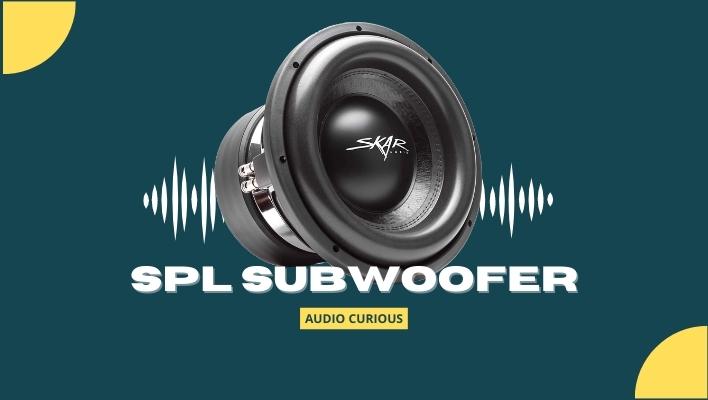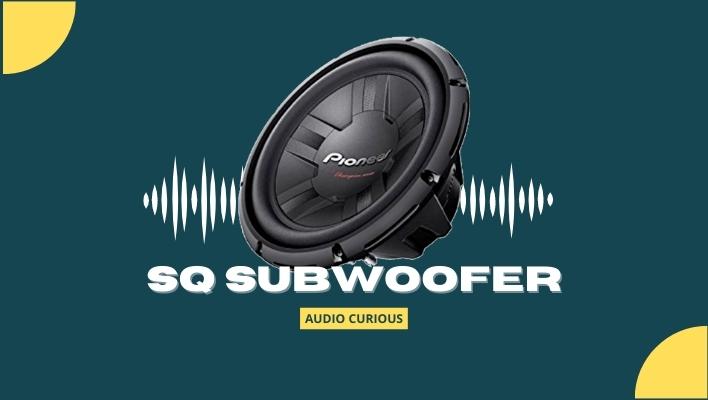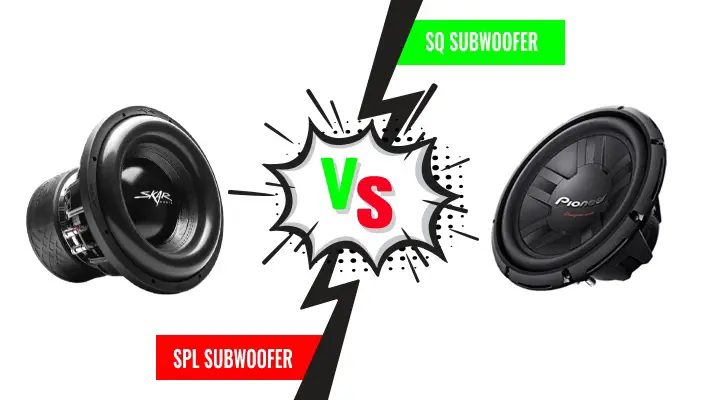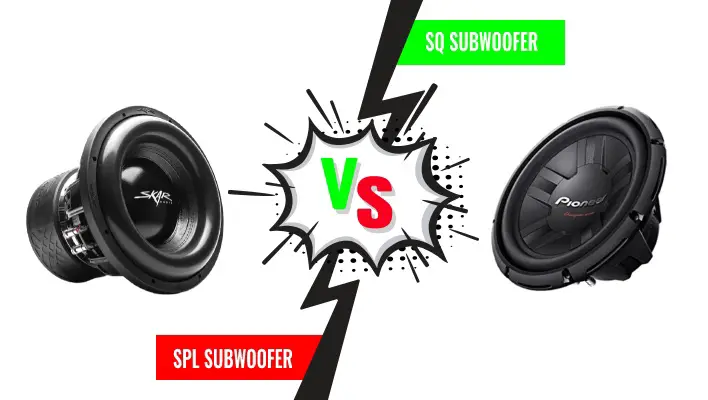When looking for that extra punch in your home or car, it’s important to know the difference between SPL and SQ subwoofers. Both are common options for a great audio experience, but which is right for you?
SPL stands for “Sound Pressure Level” and refers to the sound pressure level produced by a subwoofer. This measurement is taken at a distance of 1 meter from the subwoofer’s driver, using an SPL meter. These subwoofers make your music sound better than it does with just one pair of speakers alone.
SQ stands for “Sound Quality,” and it refers to the sound quality produced by a subwoofer. This measurement is taken at 1 meter from the subwoofer’s driver using an SQ meter. They produce low frequencies at high levels without any distortion or loss in quality due to having good damping technology built into them.
So, which of the two subs do you pick? Well, that depends on what you’re looking for. Here’s a breakdown of the differences between SPL and SQ subwoofers so you can make the best decision for your needs.

What is an SPL Subwoofer?
An SPL subwoofer is a sub designed to produce sound with high output but without much depth. The term SPL stands for Sound Pressure Level, which is the amount of sound pressure in decibels. In other words, it’s a measure of how loud the speaker is.
An SPL subwoofer is a bass-enhancing speaker designed to enhance your music’s low frequencies. These speakers are usually used in conjunction with an amplifier, which is necessary for proper operation. There are several different designs of SPL subwoofers, but the most common type has a small horn that produces sound waves in the listener’s direction.
The most basic models have a single driver and can be used as passive or active speakers. The passive ones use magnetic fields to produce sound waves, while the active version uses power from an amp to produce them. The smaller drivers in these types of speakers make them ideal for home theater setups as they don’t require an amp or anything else to work properly.
SPL subwoofers are so popular among audiophiles because they produce loud sounds without giving off any low-frequency information. This makes them ideal for people who live in apartments or small spaces where you can’t use larger speakers.
Pros:
- Very high sound quality.
- Very low distortion.
- Durable and long-lasting.
- Easy to install.
- Powerful and deep bass.
- Great for movies and music.
Cons:
- Expensive.
- Not ideal for sound quality if you want to listen to music with a high-quality sound, but it will work great with movies and other media.
- Not all models are available in the US.

What is an SQ Subwoofer?
SQ stands for “Sound Quality,” and it refers to the sound quality produced by a subwoofer. An SQ subwoofer is a high-performance subwoofer designed to make your music sound better. It’s a box that sits underneath your main speakers and is made to enhance bass frequencies. It gives you a richer, more dynamic listening experience.
Subwoofers are usually built into the cabinet of the speaker itself. This means they’re hidden from view and don’t look like traditional speakers. They work with the speaker driver to improve its performance, resulting in stronger bass sounds and improved detail.
The idea behind SQ subwoofers is that they can make your music sound better than it does with just one pair of speakers alone. If you’re looking for something that will bring out the best in your music without changing the sound of your existing speakers, then an SQ subwoofer might be just what you need.
There are two types of SQ: bass extension (how deep the bass goes) and accuracy (how true the bass sounds). The best subwoofers will have both, but they’re not always easy to quantify.
The best way to get an idea of what SQ is all about is by listening to music with a good SQ system in your home. You’ll hear all kinds of details that you wouldn’t notice otherwise. This can be hard to describe, but you can try playing your favorite songs through these systems to see if you hear anything out of place or strange.
Pros
- Affordable price, suitable for small rooms.
- It can be used as a standalone subwoofer or as a part of a larger system.
- Comes with an adjustable high-frequency level control knob to adjust the high frequencies of the sound output level, which can be useful for people with hearing problems.
- It can be placed vertically or horizontally and still deliver powerful bass without compromising sound quality.
- It is possible to connect two SQ Subwoofers together so that they can work together to produce louder and more powerful sounds than what one subwoofer can produce by itself.
- They are very powerful and can produce deep, resonant bass tonal accuracy.
- They have a very high-power handling capacity.
- They are quite compact and lightweight, making them ideal for installing in small spaces or portable applications.
Cons:
- They don’t have a very long power handling capacity (especially on smaller models).

What Are the Differences Between SPL and SQ Subwoofers?
The two subwoofer types, SPL and SQ, are often confused with each other. However, they are different in many ways. Here are some of the differences between SPL and SQ subwoofers:
- SPL subwoofers are designed for maximum output and are typically used in car audio systems competitions. They’re louder and deliver more bass than SQ subwoofers.
- On the other hand, SQ subwoofers are designed for better sound quality. They’re not as loud as SPL subs but offer more accuracy and detail in the low-frequency range.
- SPL and SQ subwoofers have different output levels. The peak output level of an SPL subwoofer is much higher than that of a quality SQ subwoofer.
- SPL subwoofers have a lower frequency bass response range than SQ subwoofers. This means that if you want to play bass-heavy music, then an SPL subwoofer will be able to reproduce it better than a quality SQ one can do so. On the other hand, if you want to play music with vocals or treble sounds that are not too high in pitch, then a quality SQ woofer will be better than an SPL one can do so.
- An SPL woofer is designed primarily for heavy bass sounds, while a quality SQ woofer is designed primarily for mid and high sounds. They can also handle heavy bass sounds well when needed as well.
- An SPL woofer has more cone area than its corresponding quality SQ woofer, which means that it has more surface area on which it vibrates.
Which Type of Subwoofer Is Better?
It can be tough to decide which type of subwoofer is better—SPL or SQ. But don’t worry, we’re here to help.
- SPL subwoofers are designed for people who want the loudest, most powerful sound possible. They’re a perfect choice if you’re looking to rock out and create a sonic boom.
- On the other hand, SQ car subwoofers are all about accuracy and detail. They produce a more subtle sound, but it’s one that’s crystal clear and true to the original recording.
So which type of subwoofer is right for you? It really depends on your individual preferences and needs. We recommend taking some time to listen to both types of subwoofers before making a decision. You may be surprised by which one you end up liking the best.
How to Choose the Right Subwoofer for Your Needs
When choosing a subwoofer, you need to decide what’s most important to you: sound quality (SQ) or SPL.
- The first thing you need to consider when buying a subwoofer is its power rating. The power rating tells you how much power your subwoofer can handle before it starts to distort or break down. A high-powered subwoofer can play louder than one with a low-powered rating.
- The second thing that you need to consider is its frequency response range. You will want a subwoofer that has a wide frequency response range. It can reproduce deep bass sounds without distorting them out of shape or causing rattling noises when played at high volumes.
- Another thing you should consider when buying a subwoofer is its size and weight capacity. A larger speaker means more power and more space for air movement within the speaker cabinet. This makes it possible for music to move freely inside the cabinet without getting trapped or blocked by other parts of your vehicle’s interior.
- SPL, or Sound Pressure Level, is all about how loud the subwoofer can get. If you’re looking for a bass that will rattle your windows and shake your floor, then you need an SPL subwoofer.
- If you care more about the quality of the sound than the quantity, then you should choose an SQ subwoofer. SQ subs produce deeper and richer bass than SPL subs, and they’re perfect for people who want to hear their music the way it was meant to be heard.

What Are the Best SPL and SQ Subwoofers on the Market?
So, you’re looking for a new subwoofer and unsure which type to choose between the SQ vs SPL subwoofers? Here’s a little breakdown of the two types to help you decide.
We hope that gives you the information you need to pick the best subwoofer for your musical need. If your priority is SPL, no further introduction is needed; for under $150, the Pioneer TS-SWX251 should be your choice.
If SQ is more important, then Best Buy has two options for you under $200: Polk Audio PSW111 and Yamaha YST-SW012. For music lovers on a budget Hsu Research VTF-2 MK3, RE Audio S8 10” or Martin Logan Dynamo 700Xtreme give a remarkable performance for their price.
Final Word
We hope we have given you adequate info to serve you well in helping you make the right choices for an upgrade to your current system. If you’re trying to decide between SPL vs. SQ subwoofers, don’t just take other people’s word for it.
We advise you to listen to them side by side, in a controlled test environment with a skilled listener that isn’t emotionally involved. You may be very surprised at your findings.
Ultimately, the decision depends on your needs and what you’re looking for in a subwoofer. Consider your budget and what kind of music you listen to most often. Then think about the size of your room and how much bass you want to hear. Once you’ve answered these questions, it will be easier to decide which type of subwoofer is right for you.

